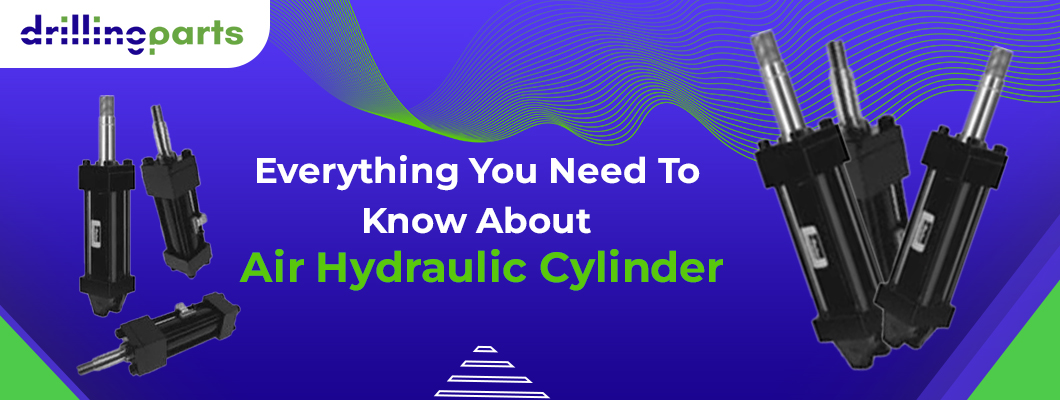
Air Hydraulic Cylinders commonly known as hydro-pneumatic cylinders or intensifier cylinders are pneumatically controlled cylinders that are engineered with great caution and higher hydraulic pressures, achieving a great stroke force that is impossible to achieve solely with pneumatic cylinders on the same bore size.
Here, in this piece of article, we are going to share a complete overview of the air hydraulic cylinder including all the features, and applications.
Let's begin by answering the most obvious question -
How Does Air Hydraulic Cylinder Work?
These hybrid air hydraulic cylinders rely on the surface area differential of an internal pneumatic piston-rod assembly to increase the pressure of trapped oil above the working piston, which is responsible for providing an intensified hydraulic cylinder output force.
Ideally, in the initial phase, these air hydraulic cylinders work like the pneumatic, double-acting cylinders, extending & retracting to the workpiece with output forces, which is a typical function of a pneumatic cylinder. However, once they are in contact with the workpiece, the second pneumatically controlled cylinder section starts to drive a rod into the oil section, sealing it, & intensifying the internal pressure. This increases oil pressure, then pushes against the working piston, increasing the output thrust.
Like the double-acting pneumatic cylinders, these air hydraulic cylinder makes use of the exhaust valve system that helps in controlling the motion. These hydraulic cylinders have a four-way valve. One out of these four-way valves is responsible for controlling the approach and retract motion, whereas the other valve controls the oil pressure intensification.
With an air hydraulic cylinder, you get the benefits of both pneumatic and hydraulic cylinders. So, it is a great investment.
Major Moving Components Of Air Hydraulic Cylinders
Simple control circuits
Air oil separation on both sides of the oil
Linear output forces up to 200 tons
Wear bands on the reservoir
Work pistons
Heavy-duty construction for durability & reliability
The service life of 20 million strokes
Gage kits, sensors, alignment couplers, and more
What Are The Notice-Worthy Features Of These Air Hydraulic Cylinders?
These air hydraulic cylinders come in a variety of designs that make them viable for several different applications. Most OEMs and machine builders use these cylinders in their presses and automation. In addition to hydraulic presses, these cylinders are also used for cranes, forges, mobile applications, and more. These air-hydraulic cylinders are also essential to the operation of excavators, balers, telehandlers, drill rigs, and dump trucks. It is a known fact that air hydraulic cylinders are the most effective as well as efficient ways of pushing, pulling, lowering, and even lifting.
Some of these applications are -
Material Piercing
Clinching
Staking
Drawing
Marking
Cutting
Folding
Riveting
Pressing
How to Select the Right Air Hydraulic Cylinder?
When you will start your search, you will come across many different options of air hydraulic cylinders. Below, we are going to share with you the factors depending on which you must choose which air hydraulic cylinder is the best for you.
These factors include -
i) Mass
The first thing that you need to consider while choosing an air hydraulic cylinder is the amount of mass that you want to move. Once you get that, you will be able to shortlist the most effective air hydraulic cylinder. For example, if you wish to move 1 ton of mass, the hydraulic cylinder needs to produce a force that is higher than 1 ton.
ii) Geometry
Another important thing to consider here is to know the nature of the mass that you need to move. For machines like the hydraulic press that is responsible for moving typically up & down, the geometry plays no vital role, but at the same time, the center of the load being moved is not accurately centered on the point of the lift force, the force required to move the mass changes. So, while looking for the air hydraulic cylinders, make sure that you are aware of the geometry of the mass you are planning to move.
iii) Bore Size
Next factor that determines the choice of these hydraulic cylinders is the bore size. The force produced by the cylinder is the product of the pressure that the system exerts multiplied by the area of the internal piston surface divided on which the pressure acts. You can use this formula to calculate the bore size requirements.
iv) Rod Size
Once you have calculated the bore size, the next very important factor determining which air-hydraulic cylinder you should buy is the rod size. Most of these cylinders come with one or two-rod options. Selecting the right rod size required careful consideration of the required stroke length. This will affect the rod buckling strength.
These are some factors that determine which hydro-pneumatic cylinder is the best for you. We hope that you consider all the points mentioned above and make the right decision.

1 Comment(s)
There are lots of features of the air hydraulic cylinder that is helpful in various types of work in a factory. This complete overview is really helpful for us & the industry Air compressor. I would appreciate the effort that you have mentioned in the blog. Keep posting.
Leave a Comment